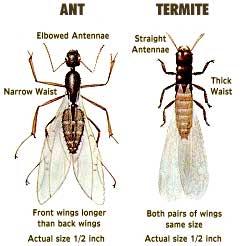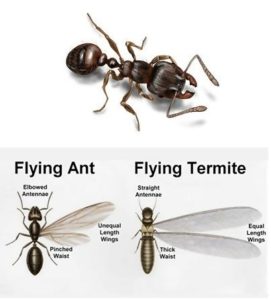Termites are one of the most destructive household pests that homeowners have to deal with. They can cause severe damage to your home’s structural integrity and can be very challenging to detect. One of the biggest challenges that homeowners face is identifying a termite from a swarming ant. This is particularly true in the case of subterranean termites, which are among the most destructive species of termites. In this article, we will discuss the termite identification differences between a termite and a swarming ant, with a focus on subterranean termites.
We will provide detailed information on seven identification differences and six appearance differences between these two pests to help homeowners protect their property from potential damage.
Why Understanding the Differences Between Termites and Swarming Ants Is Important
While both pests can swarm and potentially cause damage to a home, termites are known for causing more severe damage, often resulting in costly repairs. By correctly identifying the pest, homeowners can take necessary steps to protect their homes and prevent further damage.
Furthermore, understanding the differences between termites and swarming ants can also help homeowners prevent an infestation before it occurs. By being able to identify the signs of a potential infestation, such as discarded wings or mud tubes, homeowners can take preventative measures to keep their homes termite-free. Overall, being able to differentiate between termites and swarming ants is crucial for protecting your home and preventing an infestation.
 7 Identification Differences Between a Termite and Swarming Ant
7 Identification Differences Between a Termite and Swarming Ant
The following identification between a termite and a swarming will help you solve your pest problems at home:
1. Body Shape
One of the key differences between termites and swarming ants is their body shape. Termites have a broad, straight waist and straight antennae. On the other hand, swarming ants have a narrow waist that is pinched in the middle, and bent antennae. This is one of the easiest ways to tell the two insects apart.
2. Wings
Another way to tell the difference between a termite and a swarming ant is by their wings. Both termites and ants have wings, but there are some key differences. Termites have wings that are all the same size, while swarming ants have two sets of wings that are different sizes. Additionally, termites shed their wings once they find a mate and establish a colony, while swarming ants keep their wings.
3. Color
In terms of color, subterranean termites are typically a pale white or light brown color, while swarming ants can vary in color from red to black to brown. However, it is important to note that the color can vary depending on the species of termite or ant.
4. Behavior
The behavior of termites and swarming ants can also differ. Termites are attracted to light and will swarm around light sources, such as lamps or windows. Swarming ants, on the other hand, are attracted to moisture and will swarm around damp areas, such as sinks or showers.
5. Timing
 One of the biggest challenges in identifying a termite from a swarming ant is that both insects are most active during the springtime. This is when they emerge from their colonies to mate and establish new colonies. However, there are some key differences in the timing of the swarms. Termites typically emerge in the morning or afternoon on a warm, sunny day, while swarming ants typically emerge in the evening or at night.
One of the biggest challenges in identifying a termite from a swarming ant is that both insects are most active during the springtime. This is when they emerge from their colonies to mate and establish new colonies. However, there are some key differences in the timing of the swarms. Termites typically emerge in the morning or afternoon on a warm, sunny day, while swarming ants typically emerge in the evening or at night.
7. Habitat
Another way to tell the difference between a termite and a swarming ant is by their habitat. Subterranean termites live underground and create mud tubes to move around. Termites emerge from the ground through these mud tubes. Swarming ants, on the other hand, typically build their nests in trees, soil, or wall voids.
8. Damage
Finally, the type of damage caused by termites and swarming ants can differ. Subterranean termites feed on cellulose, which is found in wood, paper, and other materials. This can lead to severe structural damage to your home if left untreated. Swarming ants, on the other hand, do not cause as much damage to structures but can be a nuisance and cause cosmetic damage.
6 Appearance Differences Between a Termite and Swarming Ant
The appearance of both swarms might also confuse you; however, here are the differences:
1. Body size
Termites are usually smaller than swarming ants. However, this can vary depending on the species.
2. Body-color
Subterranean termites have a pale or light brown color while swarming ants can be various colors such as red, black, or brown. Some swarming ant species can even have stripes or other patterns on their bodies.
3. Wing size
Termites have wings that are all the same size, while swarming ants have two sets of wings, with the front wings being longer than the hind wings.
4. Antennae shape
The shape of the antennae can also help distinguish between a termite and a swarming ant. Termites have straight antennae, while swarming ants have bent antennae.
5. Head shape
Termites have a more rectangular head shape while ants have a more triangular-shaped head.
6. Eye size
Termites have small, black eyes while ants have larger, more prominent eyes.
Conclusion
Being able to distinguish between a termite and a swarming ant is crucial for homeowners. By knowing the identification and appearance differences between the two pests, homeowners can take necessary measures to protect their homes from potential damage. It’s important to remember that if you suspect you have an infestation, it’s always best to contact a professional pest control company to properly identify and treat the problem.
If you suspect a termite infestation in your home, contact Universal Pest for a professional inspection and effective treatment. Don’t wait until it’s too late; protect your home from termite damage today.

